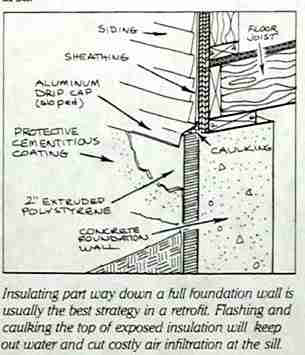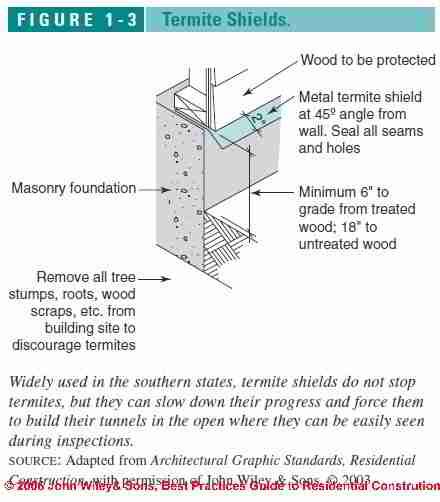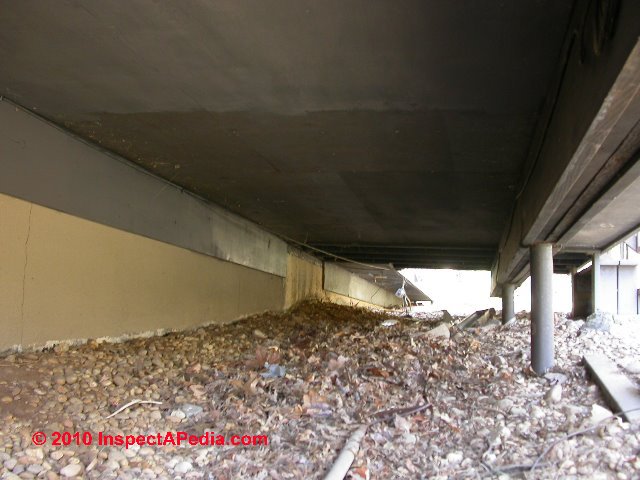 Termite Shields for Foam Board Insulated buildings
Termite Shields for Foam Board Insulated buildings
- POST a QUESTION or COMMENT about using termite shields at foam board insulated building foundations & walls
Comparison of the effectiveness of termite shields to termiticides (termite poisons or chemical barriers):
Termite shields compared with chemical poisons, bait traps, & concrete encasement of foam are discussed in this article, where Steve Bliss outlines the pros and cons of different methods used to avoid termite attack on buildings including structures whose foundations are insulated with Styrofoam™ or similar insulating board products that may form an attack pathway for insects.
We describe what termite shields are, what they look like, and how and where they are installed. We compare the effectiveness of termite shields with termite bait traps and chemical pesticide barriers as methods for controlling termite damage at or in buildings.
We also illustrate the careful use of solid concrete encasement as an approach to avoiding insect attack on a building through foam insulation.
InspectAPedia tolerates no conflicts of interest. We have no relationship with advertisers, products, or services discussed at this website.
- Daniel Friedman, Publisher/Editor/Author - See WHO ARE WE?
How to Avoid Termite Attack Through Foam Insulating Board
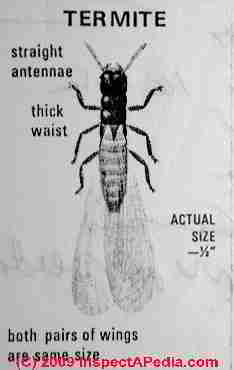
How to Avoid Termite Attack Through Foam Insulating Board
Our page top photos shows an insulated building slab during construction, leaving styrofoam exposed on the outside of the slab perimeter.
Unless protective steps are taken foam insulation board in this location is a potential path for termites or other wood destroying insects to attack the building framing.
Article Contents
- TERMITE SHIELDS vs TERMITICIDE - CONTENTS: How to Avoid Termite Attack Through Foam Insulating Board
- TERMITICIDE (termite poison) vs. Termite Shields On Styrofoam™ board insulated buildings
- TERMITE SHIELDS: Do They Work to Stop Termite Attacks on buildings?
- TERMITE BAIT TRAPS: Other Approaches to Avoiding Termite Damage
- CONCRETE ENCASEMENTof Foam Insulation as Termite Barrier
The question-and-answer article about avoiding termite damage on buildings where foam board insulation is installed, quotes-from, updates, and comments an original article from Solar Age Magazine and written by Steven Bliss.
Our sketch (left) shows some identifying characteristics of termites when seen in the "flying ants" or swarming stage.
Question: Several articles in your magazine have mentioned using polystyrene board as perimeter insulation on a slab and covering it with stucco or millboard to protect it.
Building officials in my area won't let me stucco over Styrofoam™ insulating board [POLYSTYRENE FOAM INSULATION] nor can I cover it with anything else for fear that termites will come up between the insulation and the stucco or through the foam board insulation itself, attacking the building framing.
Any suggestions?
Answer: a DOW expert recommends chemical termiticide as an insect attack barrier around foam board insulated buildings
What is a Termiticide? What's the difference between a termiticide (chemical treatment) & a termite shield?
Termiticide, not a termite shield, is the solution recommended by Jerry Severson. Severson heads research into foundation insulation at Dow Chemical Company's Granville Research Center, in Granville, Ohio.
Termiticides are chemicals that are applied in soils around a building foundation in order to form a chemical barrier to termites that might otherwise attack the building. Properly placed, a traditional termiticide chemical binds with the soil and remains in place.
At least some modern termiticides, having been chemically adjusted to reduce the risk of environmental contamination by escaping toxic chemicals, may be less durable than older, more toxic chemicals used for that purpose. -- DJF
Termites can burrow through many building materials, including all forms of insulation, and no mechanical guard offers complete protection from termites indicated Mr. Severson.
Termite poisons improperly applied to the soil under a building can give off fumes that enter the home, its heating or air conditioning systems (duct work), and can make occupants sick.
To avoid contaminating a building through improperly-applied termite chemicals, hire a reputable local pest control expert who is fully aware of the building's HVAC system design and the location of its components, and if the house is served by a private well, make sure that the well is adequately distant from any location where termiticides are to be applied.
See PESTICIDES CONTAMINATE HOUSE [PDF].
Termiticides are not normally applied to soils outside of a foundation surrounding a dirt crawl space, also because of the possible surprise entry of chemicals or fumes into the building through the crawl space soils. However special (more costly) methods may be used such as the excavation of a trench around the building, mixing the termiticide directly with the soil (making certain thereby that no chemical is escaping to where it does not belong), and the soil is then replaced in the trench.
Also make sure that the termiticide chemical [and the solvent used to apply it] to be used in the soil is not one that can harm exposed insulation around the building's foundation.
Accompanying text is reprinted/adapted/excerpted with permission from Solar Age Magazine - editor Steven Bliss.
What is a Termite Shield and Do They Work to Stop Termite Attacks on buildings?
As discussed in Best Practices Guide to Residential Construction (Steve Bliss, J Wiley & Sons) :
Metal termite shields are widely used atop foundations in the southern United States and in tropical climates as a physical barrier to termites. They sit directly on top of foundation walls, piers, and other supports before the first piece of wood is installed (see Figure 1-3 at left).
At one time termite shields were thought to block the entry of subterranean termites, the most widespread and destructive wood-boring insect in the United States.
However, subterranean termites, which nest in the soil, will exploit the tiniest gaps in termite shields or other barriers to reach the wooden portions of a house and will build tunnels along exposed foundation walls and around termite shields if necessary.
Although the shields do not stop termites, they slow down their progress and force them to build their tunnels in the open where they can be easily seen during inspections.
To work at all, the termite shield must have tightly sealed joints and be sealed around foundation bolts and other penetrations. Joints can be either soldered or mechanically interlocking. If the barrier is unsealed, termites will find any small gaps and render the effort worthless.
Also see TERMITE SHIELD Installation and also FLASHING WALL DETAILS for more information about installing termite shields
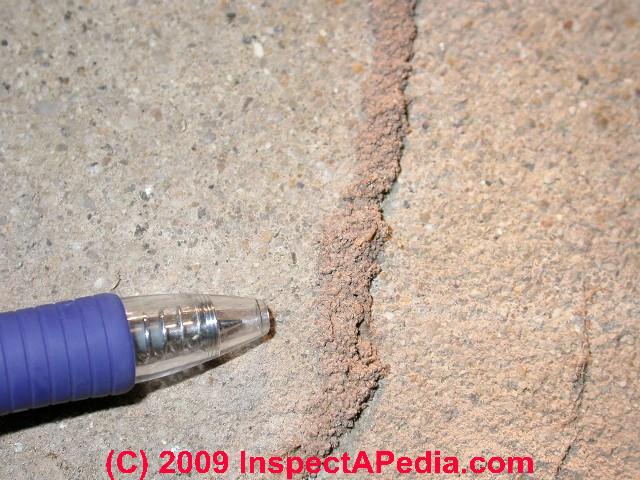
People who advocate using termite shields say that they slow down the pests so that the homeowner can spot their telltale air tubes (mud tubes) and take action against them. Our photo (left) shows a close-up of a termite mud tube climbing a poured concrete foundation exterior wall in New Jersey.
The building had no termite shield, and its sills were termite-damaged. -- DJF
A termite shield is simply a metal barrier placed atop the foundation wall and bent down over the walls to make termite passage difficult, forcing the termites to construct a mud tube around the edges of the shield, thus either making building attack more difficult for the termites, or forcing them to construct the mud tube in a location that is more easily visible to the homeowner. -- DJF
At ROT, FUNGUS, TERMITES we include photographs of termite mud tubes showing a termite attack passing below a termite shield on a building foundation wall.
Below our termite mud tube photos show that a termite shield appears to have been installed along most but not all of the building foundation top. Or was it? We don't know if this is wall flashing that leaves sills exposed just under the wall edge, or whether the flashing extends across the foundation to the interior (as recommended).
But our second termite photo (below) shows a termite mud tube ascending the same foundation wall and passing under the termite shield. The shield makes it more difficult, but not impossible, for termites to attack a building.
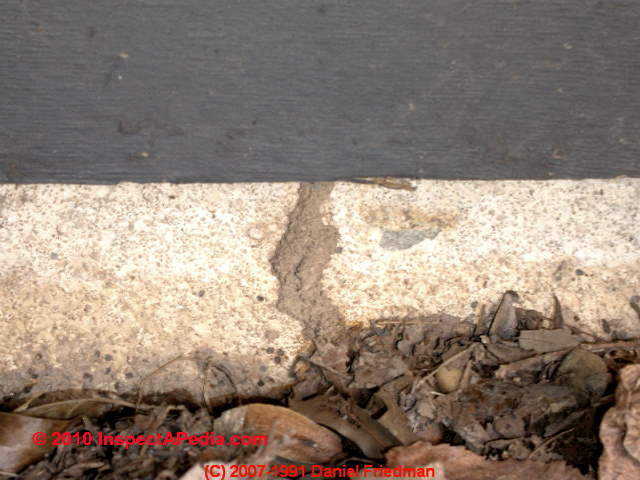
In general, termite shields should be a minimum of 6 inches above grade and extend out 2 inches on either side of the foundation at a 45 degree angle. In addition to making termite infestations visible, they also form a capillary break between the foundation and sill. Areas where a termite shield cannot be used, for example, where a concrete stairway abuts a foundation wall, are at high risk for termite entry.
In termite-prone regions, the only reliable way to prevent termite damage is to use treated wood in critical locations and treat the surrounding soil with termiticide.
See INSECT INFESTATION / DAMAGE for termite and other wood destroying insect information in depth, including termite inspection case reports, field photos and advice.
More installation details for termite shields and other building flashing can be found
at FLASHING WALL DETAILS. Readers concerned about termite damage associated with foam, fiberglass, or other building insulation materials should also
see Insects & Foam Insulation.
Also see TERMITE SHIELDS vs TERMITICIDE for a discussion of termite shields and insect attack on buildings using foam board foundation insulation.
Termite Bait Traps: Other Approaches to Avoiding Termite Damage

[The following has been added to the original Q&A, by DJF]
Termite bait traps (photo at left) are a different approach to handling a termite problem: containers holding wood sticks are buried at intervals around the building and inspected regularly by the pest control operator (PCO).
When the PCO detects that termites have begun attacking one or more of the wood baits, the operator exchanges the tasty wood for one that has been treated with a poison.
See BAIT TRAPS for Termite Control for details about termite bait traps, how they are used, and how effective they can be.
Concrete Encasement of Foam Insulation as Termite Barrier
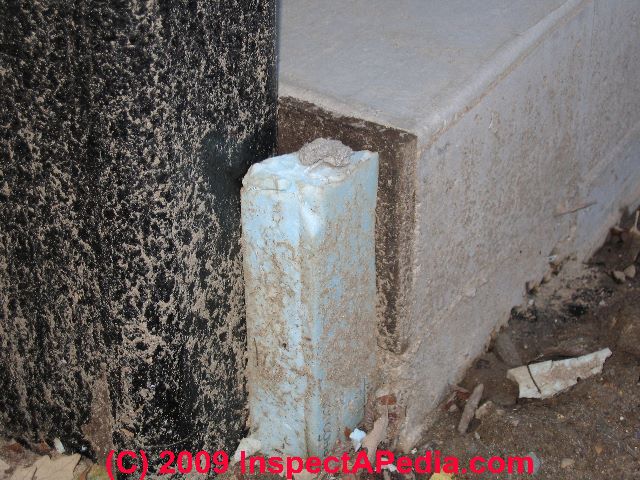
Foam perimeter insulation encasement:
At a building slab perimeter, another approach to reducing the attack path for termites where foam insulating board is used at the slab perimeter is shown in our photo of a home being built in Minneapolis, MN.
The builder has encased the foundation perimeter insulation in poured concrete, leaving about a 1/2" of solid concrete around the insulation.
Cracks in poured concrete slabs, even very tiny cracks, can form an entry path for termites into the building.
Quality of slab construction and other details can minimize this risk of insect attack, but it's also important to keep water away from the building - wet wood attacks insects.
Construction details to reduce the risk of termite damage:
include avoiding placing wood within 8" of the top of any soil, using caulking and flashing to be sure that building leaks do not wet framing lumber (making it attractive to termites), use of insect-resistant treated lumber for building wall sill plates, and similar measures.
Good design and construction practices, combined with keeping water away from building wood, can make a significant difference in the risk of termite attack on a building.
[Original article in PDF format: Avoiding Termite Attack Through Foam Insulation]
Here we include solar energy, solar heating, solar hot water, and related building energy efficiency improvement articles reprinted/adapted/excerpted with permission from Solar Age Magazine - editor Steven Bliss.
...
Continue reading at TERMITE DAMAGE INSPECTION or select a topic from the closely-related articles below, or see the complete ARTICLE INDEX.
Or see these
Recommended Articles
- ROT, FUNGUS, TERMITES
- TERMITE DAMAGE INSPECTION
- TERMITE IDENTIFICATION & CONTROL
- TERMITES & NAPTHALENE HAZARDS
- TERMITE SHIELDS vs TERMITICIDE
- VINES & SHRUBS on BUILDING WALLS, CHIMNEYS
Suggested citation for this web page
TERMITE SHIELDS vs TERMITICIDE at InspectApedia.com - online encyclopedia of building & environmental inspection, testing, diagnosis, repair, & problem prevention advice.
Or see this
INDEX to RELATED ARTICLES: ARTICLE INDEX to INSECT DAMAGE
Or use the SEARCH BOX found below to Ask a Question or Search InspectApedia
Ask a Question or Search InspectApedia
Questions & answers or comments about using termite shields at foam board insulated building foundations & walls.
Try the search box just below, or if you prefer, post a question or comment in the Comments box below and we will respond promptly.
Search the InspectApedia website
Note: appearance of your Comment below may be delayed: if your comment contains an image, photograph, web link, or text that looks to the software as if it might be a web link, your posting will appear after it has been approved by a moderator. Apologies for the delay.
Only one image can be added per comment but you can post as many comments, and therefore images, as you like.
You will not receive a notification when a response to your question has been posted.
Please bookmark this page to make it easy for you to check back for our response.
IF above you see "Comment Form is loading comments..." then COMMENT BOX - countable.ca / bawkbox.com IS NOT WORKING.
In any case you are welcome to send an email directly to us at InspectApedia.com at editor@inspectApedia.com
We'll reply to you directly. Please help us help you by noting, in your email, the URL of the InspectApedia page where you wanted to comment.
Citations & References
In addition to any citations in the article above, a full list is available on request.
- Solar Age Magazine was the official publication of the American Solar Energy Society. The contemporary solar energy magazine associated with the Society is Solar Today. "Established in 1954, the nonprofit American Solar Energy Society (ASES) is the nation's leading association of solar professionals & advocates. Our mission is to inspire an era of energy innovation and speed the transition to a sustainable energy economy. We advance education, research and policy. Leading for more than 50 years. ASES leads national efforts to increase the use of solar energy, energy efficiency and other sustainable technologies in the U.S. We publish the award-winning SOLAR TODAY magazine, organize and present the ASES National Solar Conference and lead the ASES National Solar Tour – the largest grassroots solar event in the world."
- Steve Bliss's Building Advisor at buildingadvisor.com helps homeowners & contractors plan & complete successful building & remodeling projects: buying land, site work, building design, cost estimating, materials & components, & project management through complete construction. Email: info@buildingadvisor.com
Steven Bliss served as editorial director and co-publisher of The Journal of Light Construction for 16 years and previously as building technology editor for Progressive Builder and Solar Age magazines. He worked in the building trades as a carpenter and design/build contractor for more than ten years and holds a masters degree from the Harvard Graduate School of Education. Excerpts from his recent book, Best Practices Guide to Residential Construction, Wiley (November 18, 2005) ISBN-10: 0471648361, ISBN-13: 978-0471648369, appear throughout this website, with permission and courtesy of Wiley & Sons. Best Practices Guide is available from the publisher, J. Wiley & Sons, and also at Amazon.com - Best Practices Guide to Residential Construction, by Steven Bliss. John Wiley & Sons, 2006. ISBN-10: 0471648361, ISBN-13: 978-0471648369, Hardcover: 320 pages, available from Amazon.com and also Wiley.com. See our book review of this publication.
- API Alliance for the Polyurethanes Industry Fire Safety Guidelines for Use of Rigid Polyurethane and Polyisocyanurate foam Insulation in building Construction (.pdf file)
- Termites - Greenhouse Gases, U.S. EPA, Environmental Protection Agency. Web search 09/11/2010, original source: http://www.epa.gov/ttn/chief/ap42/ch14/final/c14s02.pdf Quoting an interesting passage from this brief document:
Termites inhabit many different ecological regions, but they are concentrated primarily in tropical grasslands and forests. Symbiotic micro-organisms in the digestive tracts of termites (flagellate protozoa in lower termites and bacteria in higher termites) produce methane (CH4).
Estimates of the contribution to the global budget of CH4 from termites vary widely, from negligible up to 15 percent. - U.S. EPA. Prevention, Pesticides, and Toxic Substances. 1997. Reregistration eligibility decision: Diflubenzuron. Pp. 17, 46. www.epa.gov/ pesticides.
- U.S. EPA. Office of Prevention, Pesticides and Toxic Substances. 1994. Pesticide fact sheet: Hexaflumuron. Washington, D.C.
- U.S. EPA. Office of Pesticide Programs. 2003.
Pesticide ecotoxicity database. Unpublished database.
U.S. EPA. Prevention, Pesticides, and Toxic Substances. 1998. Reregistration eligibility decision: Hydramethylnon. Pp. 16-18, 43. www.epa.gov/pesticides. - U.S. EPA. Prevention, Pesticides and Toxic Substances. Undated. New chemical New chemical fact sheet: Noviflumuron. Washington, D.C.
- "Protecting Your Home from Subterranean Termite Damage", Journal of Pesticide Reform, Fall 2004, V 24 No. 3, - 6-7, Northwest Coalition for Alternatives to Pesticides/NCAP, POB 1393, Eugene OR, 97440 541-344-5044 www.pesticide.org: Web search 09/11/2010: http://www.hipspro.com/pubs/subterraneantermites.pdf
This document discusses alternatives for termite protection including reducing the attractiveness of the structure to termites (get wood away from the building, fix leaks), use of 16-grit sand (diameter 0.06 - 0.1 in) as a termite barrier 18" wide x 3" deep in crawl areas, or stainless steel mesh for the same purpose under foundations and slabs, boric acid, Diflubenzuron (insect growth regulator, risk genetic damage, EPA classed as carcinogen), Hexaflumuron (insect growth regulator, EPA didn't ID health concerns, waived some testing, partly because of anticipated very low risk of human exposure), Hydramethylnon (stomach toxicant, EPA: Carcinogen, highly toxic to fish), Noviflumuron (chemically similar to hexaflumuron), can cause anemia, EPA didn't ID other health hazards, some testing requirements waived, moderately toxic to fish). - In addition to citations & references found in this article, see the research citations given at the end of the related articles found at our suggested
CONTINUE READING or RECOMMENDED ARTICLES.
- Carson, Dunlop & Associates Ltd., 120 Carlton Street Suite 407, Toronto ON M5A 4K2. Tel: (416) 964-9415 1-800-268-7070 Email: info@carsondunlop.com. Alan Carson is a past president of ASHI, the American Society of Home Inspectors.
Thanks to Alan Carson and Bob Dunlop, for permission for InspectAPedia to use text excerpts from The HOME REFERENCE BOOK - the Encyclopedia of Homes and to use illustrations from The ILLUSTRATED HOME .
Carson Dunlop Associates provides extensive home inspection education and report writing material. In gratitude we provide links to tsome Carson Dunlop Associates products and services.


